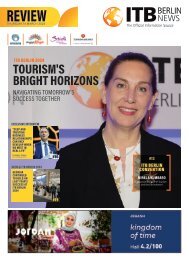HOTEL&TOURISM SMARTreport #47
You also want an ePaper? Increase the reach of your titles
YUMPU automatically turns print PDFs into web optimized ePapers that Google loves.
ASIA / PACIFIC
Hotel & Tourism
SMARTreport #47
2020 9
9
BARIO – NESTLED IN THE
HIGHLANDS OF BORNEO
A little-known remote inland region that “ticks-off
all the boxes”
Penghalu Robertson, village chief of Bario (pronounced
Bariew), holds out his hand to strangers (Pre-Covid) at the tiny
aerodrome as the passengers prepare to board a MAS Wings
Twin Otter back to the coast – one of two flights a day. The
airport is the main entry point for all travellers, unless they are
keen on taking a 12-14 hour slipping-and-sliding bone-shaking
4-wheel drive epic from Miri on the coast.
“How have you enjoyed this
place?”, the chief inquires, with
a warm, genuine smile. In a day,
the visitor will be greeted with
dozens of smiles, and will be
treated to a broad range of local
“bush caught and grown” dishes.
This place thus singularly “ticks off
all the boxes” of Sarawak Tourism
Board’s promotional themes of
culture, adventure, nature, food
and festivals.
an observer, but is accepted as a
friend or “part of the family”.
Lying at an altitude of over 1,100m,
in the north-eastern corner of
Sarawak, Bario, once known as the
“most remote village in the British
Empire”, is home to the Kelabit
people, one of the minority Orang
Ulu tribes of Sarawak (formerly
fierce head-hunters), and its name
means “wind” in their language.
Penghulu
Robertson
In past years, a large number of
research projects around the world
have pointed to the fact that
savvy travellers more and more are
looking for what could be termed
“immersive” experiences, where
they meld into a local community,
becoming as one with its people,
rather than just being observers.
Bario, through its remoteness, and
the fact there are no hotels – just
longhouses – puts one fairly and
squarely in the picture as part of
the local experience. Added to
this is the fact that the “official”
welcome ceremony for visitors
by the Kelabit people involves
the visitor participating, albeit
awkwardly, with an occasional
giggle, in dance and games with
the locals. It means one is not
“What would you say makes Bario
different?”, I ask the chief.
“Of course, there is the Bario
rice, then there is the pineapple.
It grows all over Borneo, but it’s
not as sweet as in Bario. Maybe it’s
because of the climate, or maybe
the altitude. Another thing that
is different here is the weather,
which is much cooler than on the
coast,” he replies.
The homestays provide lodging
and full board, with meals quite
often consisting of organic Bario
highland rice, wild boar or venison,
and jungle plants, topped off with
local pineapple. All organic… of
course
Village chief - Bario
You can find the online
version of the SMARTguide
on the website
www.hotelandtourismonline.com
under the “publications” menu.

















